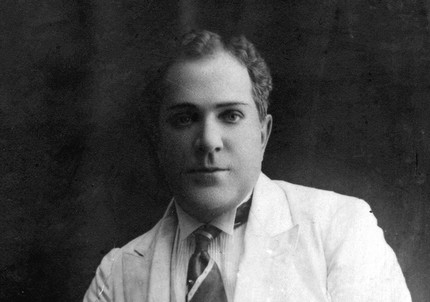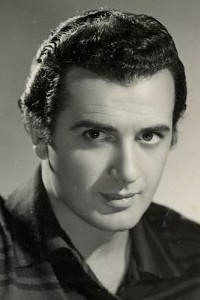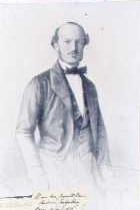
Pyotr Ivanovich Slovtsov (Pyotr Slovtsov) |
Pyotr Slovtsov

Childhood. Years of study.
The remarkable Russian singer Pyotr Ivanovich Slovtsov was born on July 12 (June 30 of the old style) in 1886 in the village of Ustyansky, Kansky district, Yenisei province, in the family of a church deacon.
In early childhood, at the age of 1,5 years, he lost his father. When Petya was 5 years old, her mother moved to Krasnoyarsk, where young Slovtsov spent his childhood and youth.
According to family tradition, the boy was sent to study at a theological school, and then to a theological seminary (now the building of a garrison military hospital), where his music teacher was P.I. Ivanov-Radkevich (later a professor at the Moscow Conservatory). Even in childhood, the boy’s silvery, sonorous treble attracted the attention of everyone around him with his beauty and wide range.
At the school and seminary, special attention was paid to singing, and Pyotr Slovtsov sang a lot in the choir. His voice stood out noticeably among the voices of the seminarians, and solo performances began to be entrusted to him.
Everyone who listened to him claimed that a brilliant artistic career awaited the young singer and, provided that Slovtsov’s voice was correctly set, in the future he could take the place of the leading lyric tenor on any major opera stage.
In 1909, the young Slovtsov graduated from the theological seminary and, renouncing his family career as a clergyman, entered the law faculty of the University of Warsaw. But six months later, his attraction to music leads him to the Moscow Conservatory, and he enters the class of Professor I.Ya.Gordi.
After graduating from the conservatory in 1912, Slovtsov became a soloist at the Kyiv Opera Theatre. A wonderful voice – a lyrical tenor, soft and noble in timbre, high culture, great sincerity and expressiveness of performance, quickly brought the young singer the love of listeners.
The beginning of creative activity.
Already at the beginning of his artistic career, Slovtsov performed with an extensive opera and chamber repertoire, recorded on records by a number of companies. In those years, many first-class tenors sang on the Russian opera stage: L. Sobinov, D. Smirnov, A. Davydov, A. Labinsky and a number of others. Young Slovtsov immediately entered this wonderful galaxy of artists as an equal.
But to this it must be added that many listeners of that time agreed on the same opinion that Slovtsov had an exceptionally rare voice in its qualities, difficult to describe. Lyrical tenor, caressing timbre, untouched, fresh, exceptional in strength and with a velvety sound, he enslaved and conquered listeners who forget about everything and are completely in the power of this voice.
The breadth of the range and amazing breathing allow the singer to give the whole sound to the theater hall, hiding nothing, hiding nothing with the wrong setting of breathing.
According to many reviewers, Slovtsov’s voice is related to Sobinovsky’s, but somewhat wider and even warmer. With equal ease, Slovtsov performed Lensky’s aria and Alyosha Popovich’s aria from Grechaninov’s Dobrynya Nikitich, which could only be performed by a first-class dramatic tenor.
Pyotr Ivanovich’s contemporaries often argued about which of the genres Slovtsov was better at: chamber music or opera. And often they could not come to a consensus, since in any of them Slovtsov was a great master.
But this favorite of the stage in life was characterized by extraordinary modesty, kindness, and the absence of any arrogance. In 1915, the singer was invited to the troupe of the Petrograd People’s House. Here he repeatedly performed with F.I. Chaliapin in the operas “Prince Igor”, “Mermaid”, “Faust”, Mozart and Salieri, “The Barber of Seville”.
The great artist spoke warmly about Slovtsov’s talent. He gave him a photo of himself with the inscription: “In good memory with heartfelt wishes for success in the world of art.” P.I.Slovtsov from F.Chaliapin, December 31, 1915 St. Petersburg.
Marriage with M.N. Rioli-Slovtsova.
Three years after graduating from the conservatory, great changes took place in the life of P.I. Slovtsov, in 1915 he got married. His wife, nee Anofrieva Margarita Nikolaevna, and later Rioli-Slovtsova also graduated from the Moscow Conservatory in 1911 in the vocal class of Professor V.M. Zarudnaya-Ivanova. Together with her, in the class of Professor U.A. Mazetti, the wonderful singer N.A. Obukhova completed the course, with whom they had a strong friendship for many years, which began at the conservatory. ‘When you’re famous,’ Obukhova wrote in her photograph given to Margarita Nikolaevna, ‘don’t give up on old friends’.
In the description given to Margarita Nikolaevna Anofrieva by Professor V.M. Zarudnaya-Ivanova and her husband, composer and director of the Conservatory M.M. Ippolitov-Ivanov, not only the performing, but also the pedagogical talent of the diploma student was noted. They wrote that Anofrieva could conduct pedagogical work not only in secondary musical educational institutions, but also in conservatories.
But Margarita Nikolaevna loved the opera stage and achieved perfection here, performing leading roles in the opera houses of Tiflis, Kharkov, Kyiv, Petrograd, Yekaterinburg, Tomsk, Irkutsk.
In 1915, M.N. Anofrieva married P.I. Slovtsov, and from now on, their path on the opera stage and in concert performances passes in close collaboration.
Margarita Nikolaevna graduated from the conservatory not only as a singer, but also as a pianist. And it is quite clear that Pyotr Ivanovich, who performed in chamber concerts, had Margarita Nikolaevna as his favorite accompanist, who perfectly knows all of his rich repertoire and has excellent command of the art of accompaniment.
Return to Krasnoyarsk. National Conservatory.
From 1915 to 1918 Slovtsov worked in Petrograd at the Bolshoi Theater at the People’s House. Having decided to feed themselves a little in Siberia, after the hungry Petrograd winter, the Slovtsovs go to Krasnoyarsk for the summer to the singer’s mother. The outbreak of the Kolchak rebellion does not allow them to return. The 1918-1919 season the singing couple worked at the Tomsk-Yekaterinburg Opera, and the 1919-1920 season at the Irkutsk Opera.
On April 5, 1920, the People’s Conservatory (now the Krasnoyarsk College of Arts) was opened in Krasnoyarsk. P.I. Slovtsov and M.N. Rioli-Slovtsova took the most active part in its organization, creating an exemplary vocal class that became famous throughout Siberia.
Despite the great difficulties during the years of economic ruin – the legacy of the civil war – the work of the conservatory was intensive and successful. Her activities were the most ambitious in comparison with the work of other musical institutions in Siberia. Of course, there were many difficulties: there were not enough musical instruments, rooms for classes and concerts, teachers were underpaid for months, summer vacations were not paid at all.
Since 1923, through the efforts of P.I. Slovtsov and M.N. Rioli-Slovtsova, opera performances have resumed in Krasnoyarsk. Unlike the opera groups that previously worked here, which were created at the expense of visiting artists, this group consisted entirely of Krasnoyarsk singers and musicians. And this is the great merit of the Slovtsovs, who managed to unite all lovers of opera music in Krasnoyarsk. Participating in the opera, not only as direct performers of responsible parts, the Slovtsovs were also directors and leaders of groups of soloists – vocalists, which was facilitated by their excellent vocal school and rich experience in the field of stage art.
The Slovtsovs tried to make Krasnoyarsk residents hear as many good singers as possible by inviting opera guest performers to their performances. Among them were such well-known opera performers as L. Balanovskaya, V. Kastorsky, G. Pirogov, A. Kolomeitseva, N. Surminsky and many others. In 1923-1924 such operas as Mermaid, La Traviata, Faust, Dubrovsky, Eugene Onegin were staged.
In one of the articles of those years, the newspaper “Krasnoyarsk Rabochiy” noted that “the preparation of such productions with non-professional artists is, in a way, a feat.”
Krasnoyarsk music lovers for many years recalled the beautiful images created by Slovtsov: the Prince in Dargomyzhsky’s ‘Mermaid’, Lensky in Tchaikovsky’s ‘Eugene Onegin’, Vladimir in Napravnik’s ‘Dubrovsky’, Alfred in Verdi’s ‘La Traviata’, Faust in Gounod’s opera of the same name.
But Krasnoyarsk residents are no less memorable for Slovtsov’s chamber concerts, which were always expected as holidays.
Pyotr Ivanovich had especially favorite works, performed with great skill and inspiration: Nadir’s romance from Bizet’s opera ‘The Pearl Seekers’, the duke’s song from Verdi’s ‘Rigoletto’, Tsar Berendey’s cavatina from Rimsky-Korsakov’s ‘The Snow Maiden’, Werther’s arioso from Massenet’s opera of the same name, Mozart’s Lullaby and others.
Creation of the “Labor Opera Group” in Krasnoyarsk.
At the end of 1924, on the initiative of the trade union of art workers (Rabis), on the basis of the opera group organized by P.I. Slovtsov, an enlarged opera troupe was created, called the ‘Labor Opera Group’. At the same time, an agreement was concluded with the city council for the use of the building of the theater named after M. A.S. Pushkin and allocated a subsidy of three thousand rubles, despite the difficult economic situation in the country.
More than 100 people took part in the opera company. A.L. Markson, who conducted the performances, and S.F. Abayantsev, who directed the choir, became members of the board and artistic directors of it. Leading soloists were invited from Leningrad and other cities: Maria Petipa (coloratura soprano), Vasily Polferov (lyric-dramatic tenor), the famous opera singer Lyubov Andreeva-Delmas. This artist had an amazing combination of a great voice and bright stage performance. One of the best works of Andreeva-Delmes, the part of Carmen, once inspired A. Blok to create a cycle of poems by Carmen. The old-timers who saw this performance in Krasnoyarsk remembered for a long time what an unforgettable impression the talent and skill of the artist made on the audience.
The first Krasnoyarsk Opera House, created by the considerable efforts of the Slovtsovs, worked interestingly and fruitfully. Reviewers noted good costumes, a variety of props, but, above all, a high culture of musical performance. The opera team worked for 5 months (from January to May 1925). During this time, 14 operas were staged. ‘Dubrovsky’ by E. Napravnik and ‘Eugene Onegin’ by P. Tchaikovsky were staged with the participation of the Slovtsovs. The Krasnoyarsk Opera was not alien to the search for new forms of artistic expression. Following the example of the capital’s theaters, the play ‘Struggle for the Commune’ is being created, in which the directors tried to rethink the classics in a new way. The libretto was based on the events of the time of the Paris Commune, and the music – from D. Puccini’s ‘Tosca’ (such artistic searches were characteristic of the twenties).
Life in Krasnoyarsk.
Krasnoyarsk people knew Pyotr Ivanovich not only as an artist. Having fallen in love with simple peasant labor since childhood, he devoted all his free time to farming throughout his life in Krasnoyarsk. Having a horse, he took care of it himself. And the townspeople often saw how the Slovtsovs drove through the city in a light carriage, heading to rest in its vicinity. Not tall, plump, with an open Russian face, P.I. Slovtsov attracted people with his cordiality and simplicity of address.
Pyotr Ivanovich loved Krasnoyarsk nature, visited the taiga and the famous ‘Pillars’. This wonderful corner of Siberia attracted many, and whoever came to Krasnoyarsk always tried to visit there.
Eyewitnesses talk about one case when Slovtsov had to sing far from being in a concert setting. A group of visiting artists gathered, and they asked Peter Ivanovich to show them ‘Pillars’.
The news that Slovtsov was on the ‘Pillars’ immediately became known to the stolbists, and they persuaded the artists to meet the sunrise on the ‘First Pillar’.
The group led by Petr Ivanovich was led by experienced climbers – the brothers Vitaly and Evgeny Abalakov, Galya Turova and Valya Cheredova, who insured literally every step of the novice stolbists. At the top, the fans of the famous singer asked Pyotr Ivanovich to sing, and the whole group sang along with him in unison.
Concert activity of the Slovtsovs.
Pyotr Ivanovich and Margarita Nikolaevna Slovtsov combined pedagogical work with concert activity. For many years they performed with concerts in various cities of the Soviet Union. And everywhere their performances received the most enthusiastic evaluation.
In 1924, the tour concerts of the Slovtsovs took place in Harbin (China). One of the numerous reviews noted: ‘The Russian musical genius is gaining more and more perfect performers before our eyes… A divine voice, a silver tenor, which, by all accounts, has no equal in Russia now. Labinsky, Smirnov and others at present, in comparison with Slovtsov’s dazzling richness of sound, are only precious gramophone records of the ‘irretrievable past’. And Slovtsov is today: sunny, crumbling with diamonds of musical sparkle, which Harbin did not dare to dream of … From the very first aria, yesterday’s success of Petr Ivanovich Slovtsov’s performances turned into a standing ovation. Warm, stormy, incessant ovations turned the concert into a continuous triumph. To say so is only to a slight extent to define the wonderful impression of yesterday’s concert. Slovtsov sang both incomparably and delightfully, he sang divinely… P.I. Slovtsov is an exceptional and unique singer…’
The same review noted the success of M.N. Rioli-Slovtsova in this concert, who not only sang beautifully, but also accompanied her husband.
Moscow Conservatory.
In 1928, P.I. Slovtsov was invited as a professor of singing at the Moscow Central Combine of Theater Arts (later GITIS, and now RATI). Along with teaching activities, Petr Ivanovich sang at the Bolshoi Academic Theater of the USSR.
The metropolitan press defined him as “a large figure, a complete vocalist, enjoying a great reputation.” The newspaper Izvestia on November 30, 1928, after one of his concerts, wrote: “It is necessary to acquaint the broad masses of listeners with Slovtsov’s singing art.”
Performing with great success in Moscow and Leningrad, he sang in “La Traviata” – with A. Nezhdanova, in “Mermaid” – about V. Pavlovskaya and M. Reizen. The newspapers of those years wrote: “La Traviata” came to life and rejuvenated, as soon as the wonderful masters who played the main roles touched it: Nezhdanova and Slovtsov, How many lyric tenors do we have who would have such an excellent school and such high skill?
The last year of the singer’s life.
In the winter of 1934, Slovtsov made a tour of the Kuzbass with concerts, in the last concerts Pyotr Ivanovich performed already sick. He was in a hurry to Krasnoyarsk, and here he finally fell ill, and on February 24, 1934 he was gone. The singer died in the prime of his talent and strength, he was only 48 years old. The whole of Krasnoyarsk saw off their beloved artist and countryman on his last journey.
At the Pokrovsky cemetery (to the right of the church) there is a white marble monument. On it are carved the words from Massenet’s opera ‘Werther’: ‘Oh, don’t wake me, breath of spring’. Here rests one of the famous Russian singers, lovingly called by his contemporaries the Siberian nightingale.
In an obituary, a group of Soviet musical figures, headed by People’s Artist of the Republic Ippolitov-Ivanov, Sobinov, and many others, noted that Slovtsov’s death “would reverberate with deep pain in the hearts of the broad masses of listeners in the Soviet Union, and the musical community would long remember the wonderful singer and great artist.”
The obituary ends with a call: “And who, first of all, if not Krasnoyarsk, should keep a long memory of Slovtsov?” MN Rioli-Slovtsova, after the death of Petr Ivanovich, continued her pedagogical activity in Krasnoyarsk for twenty years. She died in 1954 and is buried next to her husband.
In 1979, the Leningrad company ‘Melody’ released a disc dedicated to P.I. Slovtsov in the series ‘Outstanding Singers of the Past’.
Materials prepared according to the book by B.G. Krivoshey, L.G. Lavrushev, E.M. Preisman ‘Musical life of Krasnoyarsk’, Krasnoyarsk book publishing house in 1983, documents of the State Archive of the Krasnoyarsk Territory, and the Krasnoyarsk Regional Museum of Local Lore.





